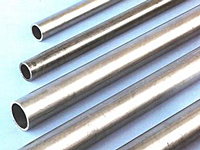| Items |

6063-T6SP10-3000-120
Seamless Aluminum Pipe - Series 6063-T6 Schedule 10
|

6063-T6SP10-4000-120
Seamless Aluminum Pipe - Series 6063-T6 Schedule 10
|

6063-T6SP10-5000-134
Seamless Aluminum Pipe - Series 6063-T6 Schedule 10
|

6063-T6SP10-6000-134
Seamless Aluminum Pipe - Series 6063-T6 Schedule 10
|
|
Material
|
N/A
Aluminum
|
|
Shapeform
|
N/A
Pipe
|
|
Series
|
N/A
6063-T6
|
|
Grade
|
N/A
6063
|
|
Preparation
|
N/A
Stenciled
|
|
Temper
|
N/A
T6
|
|
Standard
|
N/A
Schedule 10
|
|
Nominal Size
|
N/A
3 inches
|
N/A
4 inches
|
N/A
5 inches
|
N/A
6 inches
|
|
Nominal Size
|
N/A
3 inches76.2 mm
|
N/A
4 inches101.6 mm
|
N/A
5 inches127 mm
|
N/A
6 inches152.4 mm
|
|
O.D.
|
N/A
3 1/2 inches88.90 mm
|
N/A
4.500 inches114.3 mm
|
N/A
5.563 inches141.3002 mm
|
N/A
6.625 inches168.275 mm
|
|
I.D.
|
N/A
3.260 inches82.804 mm
|
N/A
4.260 inches108.204 mm
|
N/A
5.295 inches134.493 mm
|
N/A
6.357 inches161.4678 mm
|
|
Wall Thickness
|
N/A
0.12 inches3.0480 mm
|
N/A
0.12 inches3.0480 mm
|
N/A
0.134 inches3.4036 mm
|
N/A
0.134 inches3.4036 mm
|
|
Weight
|
N/A
1.4832 lbs/ft2.2072448448 kg/m
|
N/A
1.9220 lbs/ft2.860251208 kg/m
|
N/A
2.6603 lbs/ft3.9589626892 kg/m
|
N/A
3.1807 lbs/ft4.7334032348 kg/m
|
|
Weight per 20'
|
N/A
29.664 lbs13.4555904 kg
|
N/A
38.441 lbs17.4368376 kg
|
N/A
53.206 lbs24.1342416 kg
|
N/A
63.614 lbs28.8553104 kg
|
|
ASTM Specification
|
N/A
ASME SB-241 ASME SB241M ASTM B241 ASTM B241M Mil-P-25995 UNS A96063
|
|
Length
|
N/A
20 ft
|
|
Ultimate Strength
|
N/A
35 ksi
|
|
Yield Strength
|
N/A
31 ksi
|
|
Elongation percent in 2 inches
|
N/A
12
|
|
Hardness Brinnel Number
|
N/A
73
|
|
Ultimate Shearing Strength
|
N/A
22 ksi
|
|
Fatigue Endurance Limit1
|
N/A
10 ksi
|
|
Modulus of Elasticity2
|
N/A
10.0 x 103 ksi
|
|
Resistance to Corrosion - General3
|
N/A
A
|
|
Stress Corrosion Cracking
|
N/A
A
|
|
Workability (Cold)
|
N/A
C
|
|
Mechinability
|
N/A
C
|
|
Brazeability4
|
N/A
A
|
|
Gas Weldability5
|
N/A
A
|
|
Arc Weldability6
|
N/A
A
|
|
Resistance Spot and Seam Weldability7
|
N/A
A
|
|
Applications
|
N/A
Pipe railing, furniture, architectural extrusions
|
|
Density
|
N/A
0.097 lbs/in³
|
|
Specific Gravity
|
N/A
2.70
|


